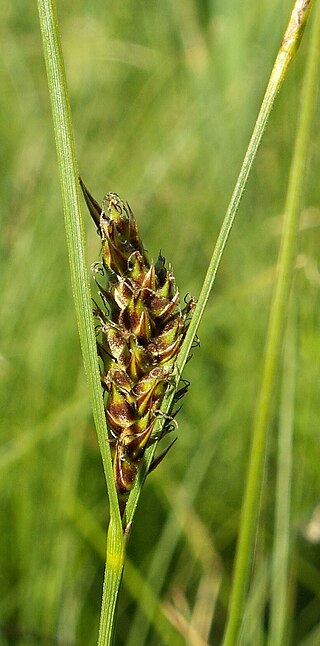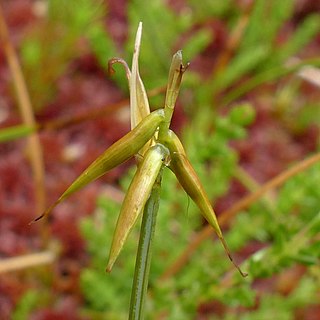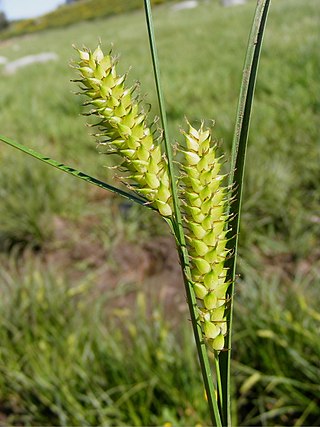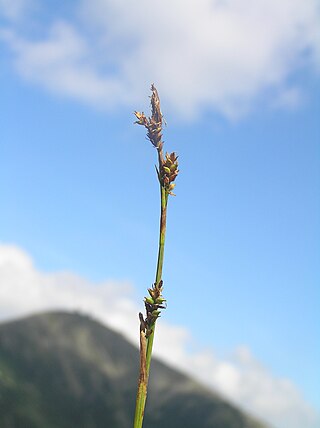
Carex is a vast genus of over 2,000 species of grass-like plants in the family Cyperaceae, commonly known as sedges. Other members of the family Cyperaceae are also called sedges, however those of genus Carex may be called true sedges, and it is the most species-rich genus in the family. The study of Carex is known as caricology.
Carex toreadora is a little-known species of sedge from Ecuador. It was described in 1964 by the prolific plant collector Julian A. Steyermark, having been collected in 1943 at an altitude of 3,785–3,900 metres (12,418–12,795 ft) in Azuay Province. There it grew in "moist mossy boggy places bordering [an] alpine lake". No further collections have ever been made, and the species is listed as endangered on the IUCN Red List. It is classified in Carex sect. Ovales, and is thought to be closely related to species such as Carex mandoniana and Carex macloviana.

Carex lasiocarpa is a broadly distributed species of wetland sedge sometimes known as woollyfruit sedge or slender sedge. It is considered a species of Least Concern by the IUCN Red List due to its extensive range with many stable populations.

Carex pauciflora, the few-flowered sedge, is a perennial species of sedge in the family Cyperaceae native to bogs and fens in cool temperate, subarctic, and mountainous regions of the Northern Hemisphere. The specific epithet pauciflora refers to the Latin term for 'few flowered'.

Carex vesicaria is an essentially Holarctic species of sedge known as bladder sedge, inflated sedge, and blister sedge. It has been used to insulate footwear in Norway and among the Sami people, and for basketry in North America.

Scirpus ancistrochaetus is a rare species of flowering plant in the sedge family known by the common names barbedbristle bulrush and northeastern bulrush. It is native to the northeastern United States from New Hampshire south to Virginia. It used to be found in Quebec but it is now thought to be extirpated there. It was also believed extirpated from the state of New York, but at least one population has been rediscovered in Steuben County in 2010. It is threatened by the loss and degradation of its wetland habitat. It is a federally listed endangered species.

Carex vaginata is a species of sedge known by the common name sheathed sedge.

Carex lacustris, known as lake sedge, is a tufted grass-like perennial of the sedge family (Cyperaceae), native to southern Canada and the northern United States. C. lacustris us an herbaceous surface-piercing plant that grows in water up to 50 cm (1.6 ft) deep, and grows 50–150 cm (1.6–4.9 ft) tall. It grows well in marshes and swampy woods of the boreal forest, along river and lake shores, in ditches, marshes, swamps, and other wetland habitat. It grows on muck, sedge peat, wet sand or silt, in filtered or full sunlight.
Carex bulbostylis, known as the false hair sedge, is a species of sedge native to the southcentral and southeastern United States. It was first formally named by Kenneth Mackenzie in 1915. It is also known as the eastern narrowleaf sedge, thick style sedge, and globose sedge.

Carex rosea, the rosy sedge, is a flowering plant and part of the family Cyperaceae. Synonyms for Carex rosea include Carex concoluta, and Carex flaccidula. It is native to central and eastern North America and it exists in wet to dry soils. Carex rosea can be found in shores of streams and bottomlands, as well as ponds. It is known to have good adaptations to dry-shade locations. It is an evergreen plant which is easy to grow.

Carex bermudiana, the Bermuda sedge, is a sedge endemic to the islands of Bermuda. It is found on damp forest floors and in peat marshes and has become extremely rare. The Bermuda sedge was listed on the IUCN Red List of Threatened Species in November 2014 with Endangered status. This species is listed on the Bermuda Protected Species Act.

Carex viridula, known as little green sedge, green sedge, or greenish sedge, is a small flowering plant native to North America, Europe, Asia, and Morocco.

Carex bicolor, the bicoloured sedge, is a species of sedge native to North America, Northern Europe and Northern Asia. The International Union for Conservation of Nature has assessed the plant's conservation status as being of least concern because it has a widespread distribution and faces no particular threats.

Carex atlantica, the prickly bog sedge, is a species of flowering plant in the family Cyperaceae, native to eastern North America, and eastern Hispaniola. It is usually found growing in bogs or acidic seeps.

Carex filicina is a tussock-forming species of perennial sedge in the family Cyperaceae. It is native to parts of Asia from Pakistan in the north west to Indonesia in the south east.
Carex hildebrandtiana is a tussock-forming species of perennial sedge in the family Cyperaceae. It is native to central parts of Madagascar. The plant is listed as a Vulnerable species according to the International Union for Conservation of Nature.
Carex phacota, the lentoid sedge, is a species of flowering plant in the family Cyperaceae. It is native to parts of the Indian Subcontinent, Southeast Asia, most of Malesia, New Guinea, central and southern China, Hainan, Taiwan, Korea, the Ryukyus, and Japan. A pioneer species adapted to disturbances such as fire and landslides, it is typically found in wet grasslands, ditches, the banks of streams, and the sides of roads, and is categorized by the IUCN as Least Concern.

Carex folliculata, the northern long sedge, is a species of flowering plant in the family Cyperaceae. It is native to eastern Canada, and the eastern United States. A clumping perennial reaching 150 cm (5 ft) but usually shorter, it has broad, yellowish-green leaves. An obligate wetland species, it is found in a wide variety of wet habitats from sea level up to 1,800 m (5,900 ft), and can handle acidic, neutral, and basic conditions.

Carex scabrata, the eastern rough sedge, is a species of flowering plant in the family Cyperaceae. It is native to eastern Canada and the eastern United States, with one collection each in the Ozark and Ouachita mountains. A perennial reaching 90 cm (3 ft), it is found it wet areas with rich soils, particularly on seepage slopes.

Carex prasina, the drooping sedge, is a species of flowering plant in the family Cyperaceae, native to eastern Canada, and the north-central and eastern United States. It is usually found growing in rich soils in deciduous forests, typically in wet places such as streamsides, seeps, springs and fens.

















